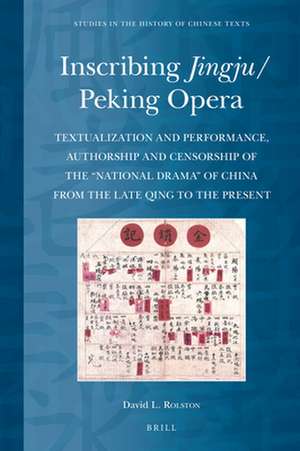Inscribing <i>Jingju</i>/Peking Opera: Textualization and Performance, Authorship and Censorship of the “National Drama” of China from the Late Qing to the Present: Studies in the History of Chinese Texts, cartea 12
Autor David Rolstonen Limba Engleză Hardback – 15 iul 2021
This book shows how increasing textualization and the resulting fixation of a performance tradition that once privileged improvisation changed the genre. It traces, from Jingju’s birth in the 19th century to the present, how texts were used for the production and consumption of this important performance genre and the changes in the concepts of authorship, copyright, and performance rights that took place during the process. The state’s desire to police what was performed is shown to have been a major factor in these changes.
The scope and coverage of the book is already unprecedented, but it is also supplemented by an additional chapter (on where the plays were performed, who performed them, and who went to see them) available for download online.
Preț: 1198.72 lei
Preț vechi: 1461.85 lei
-18% Nou
Puncte Express: 1798
Preț estimativ în valută:
229.38€ • 239.98$ • 190.54£
229.38€ • 239.98$ • 190.54£
Carte indisponibilă temporar
Doresc să fiu notificat când acest titlu va fi disponibil:
Se trimite...
Preluare comenzi: 021 569.72.76
Specificații
ISBN-13: 9789004461925
ISBN-10: 9004461922
Dimensiuni: 155 x 235 mm
Greutate: 0 kg
Editura: Brill
Colecția Brill
Seria Studies in the History of Chinese Texts
ISBN-10: 9004461922
Dimensiuni: 155 x 235 mm
Greutate: 0 kg
Editura: Brill
Colecția Brill
Seria Studies in the History of Chinese Texts
Notă biografică
David L. Rolston has been teaching Chinese language and literature at the University of Michigan since he obtained his Ph.D. in 1988. His previous research focus was traditional Chinese fiction, resulting in two books, How to Read the Chinese Novel (1990) and Traditional Chinese Fiction Commentary (1997). Since then he has concentrated on traditional Chinese theater, publishing many articles on that subject in Chinese.
Cuprins
Preface
Acknowledgments
Introduction: What Is Jingju, and Why Should We Care about It?
1 Names, Names, Names
2 Why Should We Care about Jingju?
1 Jingju Repertoire(s) and Types of Plays and Playscripts
1 The Repertoire(s)
2 Types of Plays
3 Types of Playscripts
2 Textualization and Authorship before Xikao (Research into Plays)
1 Authorship and Textualization of “Classical Chinese Indigenous Theater”
2 Two Kinds of Early Literati Jingju Playwrights and the Common Fate of Their Plays
3 Early “Ordinary” Actors as Playwrights
4 Literati Who Became Actors and Also Wrote Plays
5 Early “Professional” Playwrights
3 The Production of a Mass-Market Collection of Jingju Playscripts: Xikao (Research into Plays)
1 The Publication History of Xikao
2 What Is Xikao? The Title(s)
3 What Is Xikao? Looking for the Master Plan
4 Who Put Xikao Together?
5 Where Did the Playscripts Come From?
6 The Photos
4 After Xikao: The Rise of Theater Studies, Copyright, and New Censorship Regimes
1 Evaluation of Xikao
2 New Approaches That Arose at Least Partially in Reaction to Xikao
5 New Kinds of Playwrights
1 Chen Moxiang: The Most Prolific Jingju Playwright of the Republican Era
2 Weng Ouhong: The Most Prolific/Famous Jingju Playwright
3 Playwriting after Weng Ouhong
6 New Kinds of Publication
1 Single Plays Published in Anthologies
2 Single Plays Published as Books
3 Single Plays Published in Periodicals
4 New Media and the Recording of Image, Movement, and Sound
5 Recording More Detail in Play Texts: Adding Graphic Elements and Photographs
6 New Recording Media and New Ways of Telling Plays (Shuoxi)
7 New Recording Media: DVD Bonus Features, Digitization, Hypertexts, and the Web
Epilogue: Living with Textual Fixity
Appendix: List of Plays in Xikao
Select Bibliography
Index
Acknowledgments
Introduction: What Is Jingju, and Why Should We Care about It?
1 Names, Names, Names
2 Why Should We Care about Jingju?
1 Jingju Repertoire(s) and Types of Plays and Playscripts
1 The Repertoire(s)
2 Types of Plays
3 Types of Playscripts
2 Textualization and Authorship before Xikao (Research into Plays)
1 Authorship and Textualization of “Classical Chinese Indigenous Theater”
2 Two Kinds of Early Literati Jingju Playwrights and the Common Fate of Their Plays
3 Early “Ordinary” Actors as Playwrights
4 Literati Who Became Actors and Also Wrote Plays
5 Early “Professional” Playwrights
3 The Production of a Mass-Market Collection of Jingju Playscripts: Xikao (Research into Plays)
1 The Publication History of Xikao
2 What Is Xikao? The Title(s)
3 What Is Xikao? Looking for the Master Plan
4 Who Put Xikao Together?
5 Where Did the Playscripts Come From?
6 The Photos
4 After Xikao: The Rise of Theater Studies, Copyright, and New Censorship Regimes
1 Evaluation of Xikao
2 New Approaches That Arose at Least Partially in Reaction to Xikao
5 New Kinds of Playwrights
1 Chen Moxiang: The Most Prolific Jingju Playwright of the Republican Era
2 Weng Ouhong: The Most Prolific/Famous Jingju Playwright
3 Playwriting after Weng Ouhong
6 New Kinds of Publication
1 Single Plays Published in Anthologies
2 Single Plays Published as Books
3 Single Plays Published in Periodicals
4 New Media and the Recording of Image, Movement, and Sound
5 Recording More Detail in Play Texts: Adding Graphic Elements and Photographs
6 New Recording Media and New Ways of Telling Plays (Shuoxi)
7 New Recording Media: DVD Bonus Features, Digitization, Hypertexts, and the Web
Epilogue: Living with Textual Fixity
Appendix: List of Plays in Xikao
Select Bibliography
Index














